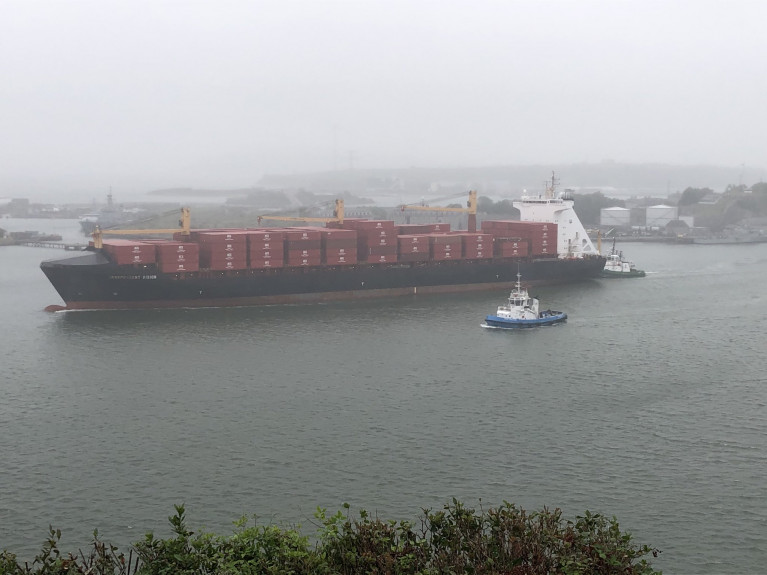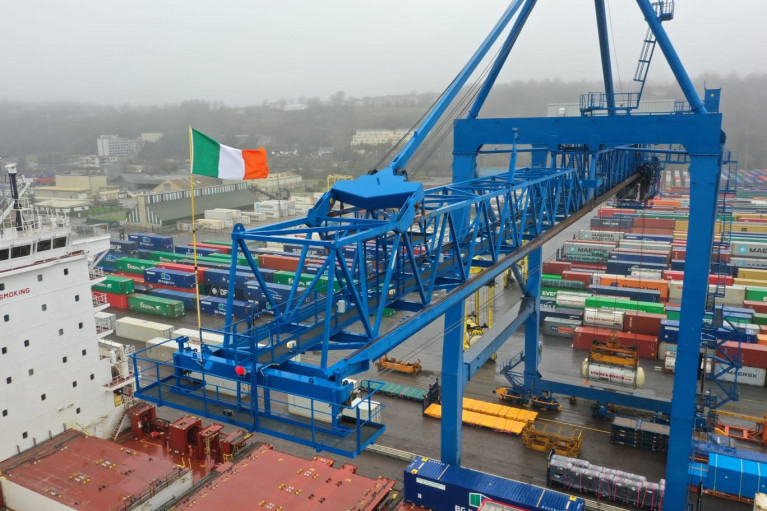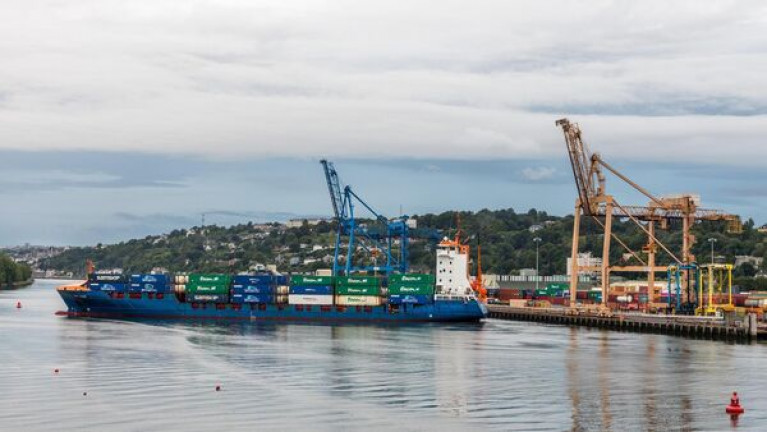Displaying items by tag: CSO figures
Figures from CSO Show Irish Ports Handled 11.8 Million tonnes of Goods in Q3, 2023 - Decrease of 4% on Last Year
Irish Ports handled 11.8 million tonnes of goods in Q3 of 2023, according to Central Statistics Office (CSO) figures - for the period of July, August and September - a 4% decrease compared with same quarter 2022.
As RTE News reports, the amount of goods forwarded from Irish Ports was 3.8 million tonnes in Q3 last year, while almost 8m tonnes of goods were received.
The CSO figures reveal, when compared with Q2 also of 2023, the total amount of tonnes in goods fell by 3% through the nation’s ports.
During Q3, 2023 the total number of merchant ships (3,130) that arrived to Ireland’s main ports: Bantry, Cork, Drogheda, Dublin, Rosslare, Shannon and Waterford - fell by 2% (3,202) when compared with the third quarter of 2022.
In the capital, the state owned Dublin Port Company, accounted for 61% of all vessel arrivals in Irish ports and 51% accounted in the total tonnage of goods handled over the three-months under review.
The CSO’s Statistics Of Port Traffic results (click here) has shown that Great Britain & Northern Ireland accounted for 38% of the total tonnage of goods handled through main ports by region of trade in Q3, while EU countries made up 40% of total tonnage of goods handled throughout the bloc's main ports.
Irish Ports according to the Central Statistics Office figures released today show that they handled a total of 11.9 million tonnes of goods in the first quarter of the year.
As RTE News reports, this level of goods represented a decrease of 6% when compared with the same time last year.
The CSO’s Statistics of Port Traffic Quarter 1 2023 said that goods forwarded from Irish ports amounted to nearly 4 million tonnes within the first three months of the year.
In this Q1 period, the CSO added that a total of 7.9 million tonnes of goods were received.
As for the total number of commercial vessels that called in Irish ports during the first quarter of 2023, of the seven main ports – Drogheda and Dublin, Rosslare (Leinster) and Bantry, Cork, Shannon and Waterford (Munster) had decreased by 5% compared with Q1 of 2022.
Also amongst the key figures revealed was that Dublin Port had accounted for 63% of all vessel arrivals in Irish ports. In addition the capital port is where 51% of the total tonnage of goods were handled in January, February and March of this year.
Across the border and the Irish Sea is where Great Britain & Northern Ireland had accounted for 37% of the total tonnage of goods handled in the main ports by region of trade.
On mainland continental Europe, countries within the EU had resulted for 42% of the total tonnage of goods handled in seven major ports, the CSO added.
Irish Ports Handled Goods Which Dip 1% in 2022 - CSO
Figures released from the Central Statistics Office (CSO) show that Irish ports in 2022 handled a total of 53.2 million tonnes of goods, this represented a dip of 1% when compared to the previous year.
According to the CSO's Statistics of Port Traffic (Q4 and Year 2022), goods forwarded from Irish ports had amounted to 16.9 million tonnes in 2022. As for goods received, this amounted to a total of 36.3 million tonnes entering the nation.
Irish ports had forwarded goods totalling 17.4 million tonnes in 2021 and in the same year 36.6 million tonnes of goods were received.
For figures regarding Great Britain & Northern Ireland they accounted for 35% of the total tonnage of goods handled based from main ports by region of trade in 2022.
In countries of the European Union, the bloc had accounted for 40% of the total tonnage of goods handled in the main ports.
There was a decrease in the number of vessels that called to Irish ports in 2022 with 12,447 vessels, down 266 vessels from a total of 12,713 vessels that arrived last year.
RTE News has more on the CSO figures.
As for tonnage of goods handled, Afloat adds, they decreased in three of five traffic categories in 2022, where there was a percentage increase in Roll-on/roll-off traffic (Ro-Ro) of 5% and Liquid bulk that was at 3%.
For more of the latest CSO figures including passenger based they can be studied here.
Exports of Irish Goods Surpass Value of Last Year’s Total in First 10 Months of 2022
Exports of Irish goods have been more in the first 10 months of 2022 when compared to the entirety of last year according to Central Statistics Office (CSO) figures released today.
The CSO's latest unadjusted figures show goods exports in October had reached a total value of €17.6 billion. This figure was €2.6 billion or 18% higher than the level seen in October 2021.
As The Irish Times reports, of the goods exported, the value is now running 29% higher for the first 10 months of this year when compared to the previous year.
“Exports for January to October 2022 were more than €176 billion. This value already exceeds the total exports for the year 2021 of €165 billion,” said Ciarán Counihan, a statistician in the CSO’s international trade in goods division.
For further statistics of trading to the UK, the EU and the USA, click the newspaper here
Trade Handled through Main Irish Ports Up 1% in Q2
The Central Statistics Office (CSO) has released new figures that show Irish ports handled a total of 13.1 million tonnes of goods in the second quarter of 2022, an increase of 1% compared with the same time last year.
Of the seven main Irish ports - Dublin Port, Bantry, Cork, Drogheda, Rosslare, Shannon and Waterford - 3,085 vessels in total arrived during the three months from April to June.
This marked an increase of 2% on the same time last year.
Also according to the CSO was that Dublin port had accounted for 63% of all vessel arrivals in Irish ports in the three month period.
For more RTE News reports on statistics from trade between Northern Ireland and Britain.
Vessel Numbers Arriving in Irish Ports Rose By 7%
New Central Statistics Office figures show that the number of vessels arriving in Irish ports last year rose by 7% on 2020 levels.
The gross tonnage of all arriving vessels in 2021 also increased by 7%, the CSO said.
Irish ports handled nearly 54 million tonnes of goods in 2021, an increase of 5% compared with 2020.
The CSO said that goods forwarded from Irish ports amounted to 17.4 million tonnes in 2021, while a total of 36.5 million tonnes of goods were received.
Today's CSO figures also show that over one million passengers passed through Irish ports last year, a jump of 25% compared with 2020.
More RTE News has to report on the port statistics.
Unadjusted exports of goods from Ireland, exceeded €20 billion in a month for the first time in March, driven mainly by growth in the exports of medical and pharmaceutical products, as well as organic chemicals, new data from the Central Statistics Office (CSO) shows.
The data also shows that imports exceeded €11 billion for the first time on record. Imports from Britain grew by 39 per cent to €1.9 billion, driven mainly by increases in the imports of mineral fuels and chemicals.
However, CSO statistician Ciarán Counihan pointed out that the large growth rate in imports from Britain is partly explained by the relatively low level of imports in March 2021 when customs documentation was required for trade.
Seasonally adjusted goods exports increased by €2 billion (+12 per cent) to €18.4 billion in March compared with February.
Seasonally adjusted goods imports decreased by €241 million (-2 per cent) to €9.7 billion, leading to an increase of €2.4 billion (+34 per cent) in the seasonally adjusted trade surplus to €8.7 billion in March compared with the previous month.
The Irish Times has more from the CSO figures.
Highest Ever Level of Exports Hits €165 Billion in 2021
Irish goods exports in value have soared to a record €165 billion last year despite the disruption to global trade caused by the pandemic.
The full-year (Central Statistics Office) figures for 2021 show trade with the UK has been impacted by Brexit, however.
While Irish exports to Britain were up by €2 billion or 17 per cent in the 12 months to the end of December, imports of goods from Britain were down by nearly €2.4 billion or 13 per cent.
Since the UK’s departure from the EU on January 1st, 2021 firms have faced increased customs requirements.
Marks and Spencer (M&S) said last year that post-Brexit rules and “excessive paperwork” has forced it to cut about 800 lines from its stores in the Republic.
But the fall-off in imports has coincided with a significant uptick in cross-Border trade on the island of Ireland.
The Irish Times has more on the CSO figures including an exports/imports graph .
Traffic in Irish Ports Increases Above Pre-Pandemic Levels
According to the Central Statistics Office, the amount of goods handled by Irish Ports in the second quarter of this year increased above pre-pandemic levels.
Figures also from the CSO show nearly 13m tonnes of goods were handled between April and June. This is an increase of 17.4% compared with the same period last year and an increase of 5.1% compared with the second quarter of 2019.
By tonnage, Dublin Port handled the largest amount of cargo of 6.3m tonnes followed by Shannon Foynes with 2.5m tonnes and Cork with 2.4m tonnes.
The figure for Cork is the largest over the past five years.
The Irish Examiner has more CSO statistics
Exports of goods rose by €1.1bn to Britain, and imports fell by €2.5bn, in the first six months this year, as companies rushed to adjust their supply chains across the Irish Sea following December's hard Brexit deal.
At over €6.7bn, the total value of goods exports to Britain was up by €1.1bn in the first half of the year from the same period in 2020, while imports from Britain fell sharply, by €2.5bn to €5.3bn.
The CSO figures may also point to changes in supply chains within the island of Ireland and potentially to a strengthening of the all-Ireland economy.
According to the CSO, exports to the North form the Republic rose to over €1.5bn in the first six months from €1.1bn a year earlier, while imports also rose to €1.7bn in the same period from around €1bn a year earlier.
In June, exports to Britain rose by €575m to €1.4bn from June 2020, helped by increases in chemicals and machinery, while imports in the month from Britain fell by €213m to €1bn.
The CSO figures also point to the overall disruption caused by the Covid-19 crisis, as Irish exports to the EU fell, and imports rose by a significant amount over the same period.
More from the Irish Examiner here.




























































